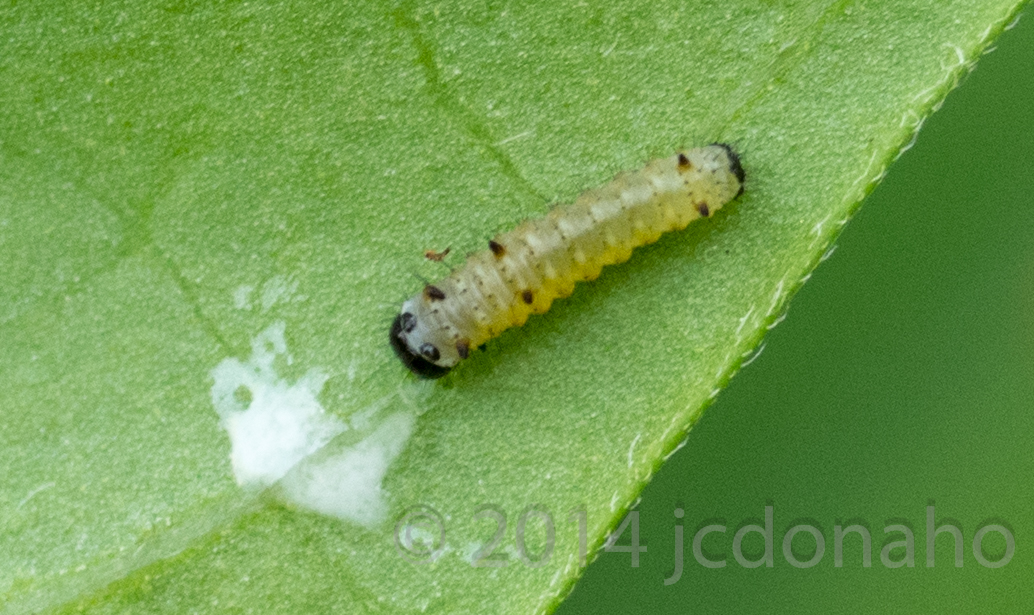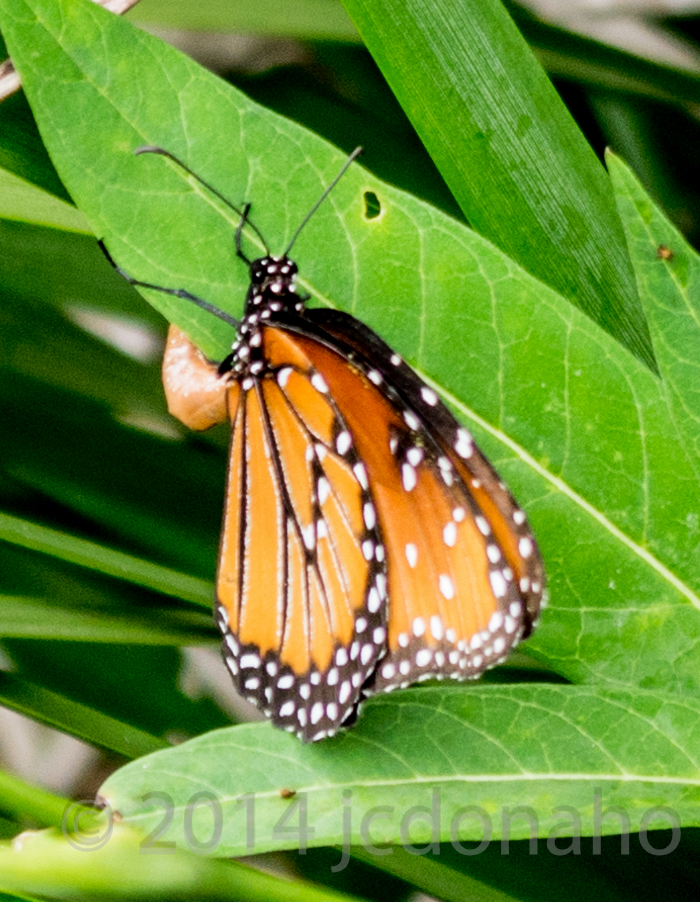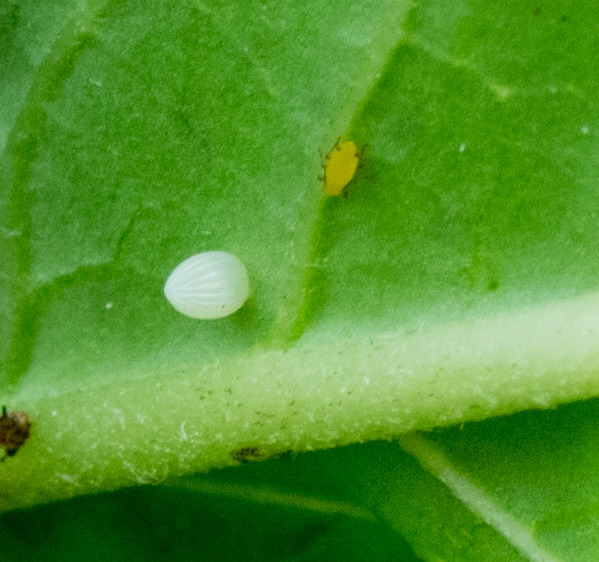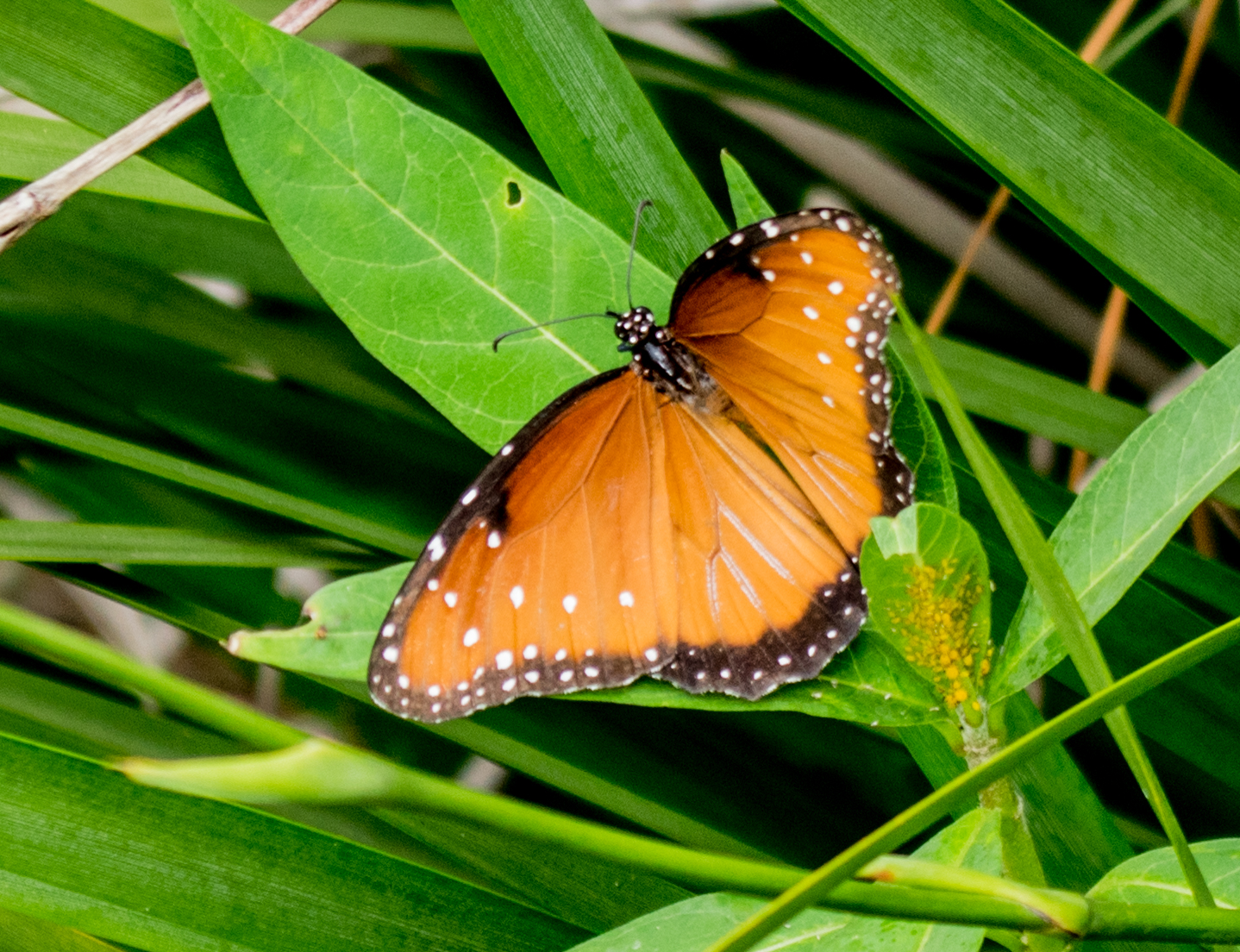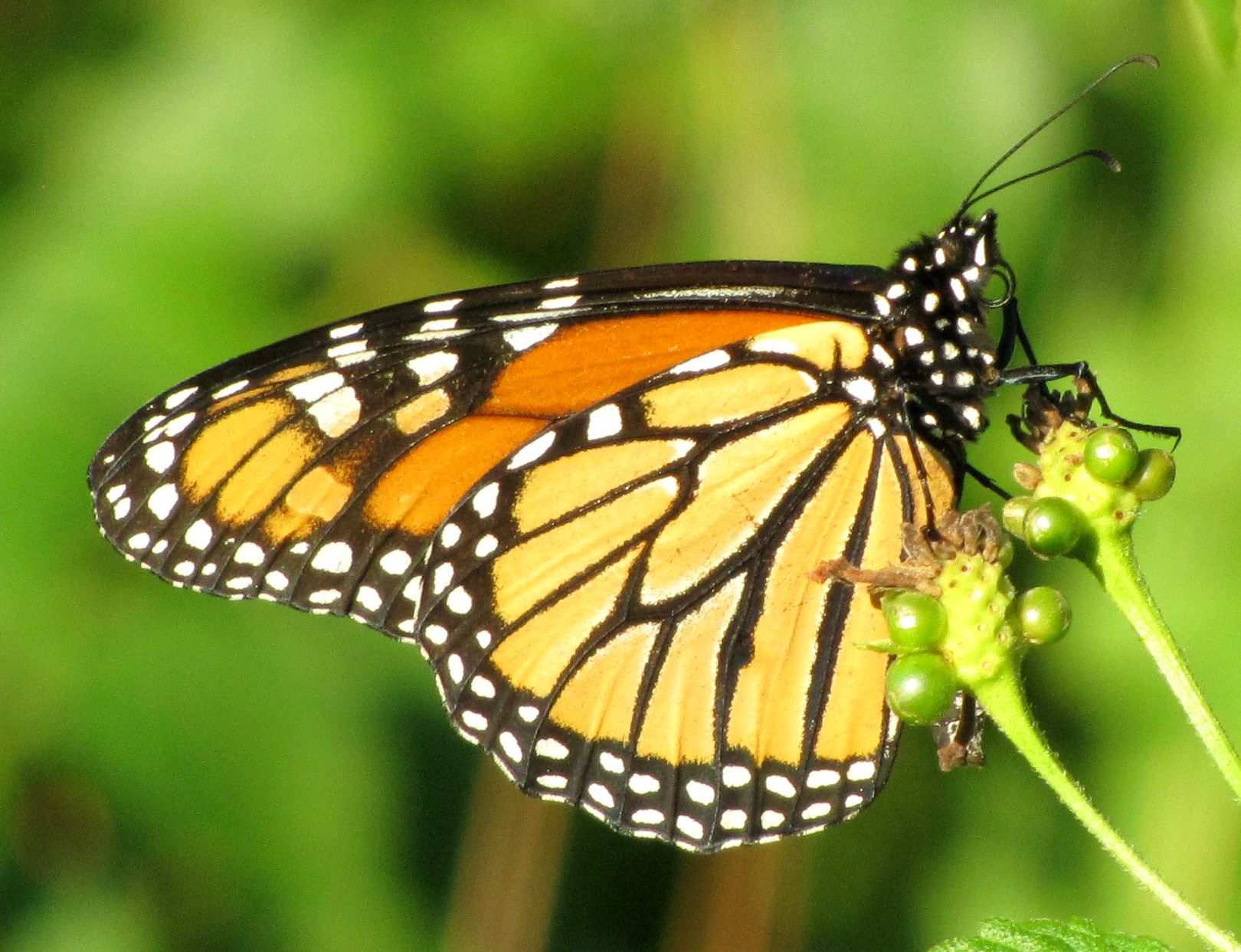The next stage of butterfly growth has begun. This is day 4 since I saw the female Queen Butterfly lay an egg on this leaf. What we are seeing is the 1st instar stage of the new caterpillar. As you can see, it is very tiny. It is very hard to see without a magnifying glass. But it will grow rapidly and then molt (shed the old skin) into the next larger instar. The Queen Butterfly caterpillar will go through 5 instar stages before it goes into the pupal stage to complete the metamorphosis into a butterfly. I am going to continue trying to follow this caterpillar on its journey from egg to butterfly. Will he or she make it? There are many perils for small animals in the wild. Stay tuned!
Archives
What is that Butterfly Doing?
A couple of days ago, I happened to see a lovely orange butterfly in the front flowerbed. But it wasn’t going to the flowers. It was landing deep in the plant. I thought that was weird. Normally the butterflies are flitting from flower to flower drinking nectar. What is that butterfly doing?
The camera was handy so I took a few shots. I wanted to identify the butterfly and maybe get a good picture. I didn’t have my best butterfly lens installed on the camera at that time so the pictures are not as good as I like.
What I did see in those pictures was the butterfly laying eggs.
That is what she was doing down inside the leaves of the plant! By the time I came back out with a good macro lens, she was gone. Carefully lifting leaves, I found several small single white eggs on the plant’s leaves. She had placed them one to a leaf.
It was time for some research on this butterfly. I am hardly an expert on insects. Each time I see something new I have to research it to understand what I have seen. That is part of the fun of doing wildlife photography. It is fun doing the research and learning about this wonderful world.
It was a Queen Butterfly that I had seen in my garden that day. I, at first, thought she might be a Monarch. But the Queen doesn’t have those dark black wing veins like a Monarch. Monarch wings remind me of a stained glass window.
I found out that the Queen Butterfly is found in many parts of the world with temperate climates. The milkweed plant she used to lay her eggs was chosen as a host because the Queen butterfly caterpillars or larvae feed on milkweed. This is a common tactic with many insects to assure the young have the correct food source. If you know the food source of the caterpillar or other insect young, you can usually find those insects. I also found out in my research that the Queen does indeed lay only one egg per leaf. This makes sense since the newly hatched caterpillars will have less competition for food on their leaf when they hatch. They also tend to eat other small caterpillars!
If all goes well, the caterpillar will emerge from the egg in another day or so. It takes 3-5 days for the egg to ‘hatch’. I hope to see and photograph the new caterpillar at that time. The caterpillars go through growth stages called instars. It will be fun to watch them eat, poop and grow over the summer.
A side benefit of looking so closely under the leaves was discovering the tiny Yellow Aphids. If they become too numerous they can cause the plant to die. The only safe method I can find to rid the plant of aphids without killing the butterfly eggs too is to dab each aphid with a cotton swab soaked in rubbing alcohol. I may let nature take its course instead. I’ll find out pretty quickly if the young caterpillars will eat aphids.
Stay tuned. This is the first time I have tried following a butterfly life cycle “in the wild”. It should be fun!
On Chasing Goats (or Butterflies)
One of the hard l essons new zookeepers must learn is how to catch animals. I was always amused to see it happen. The animal runs and the zookeeper chases. It is how we are wired. The animals zig and zag until the zookeeper is exhausted. It doesn’t matter if the chase involves a dog, zebra, goat or a butterfly. Catching up is very difficult to do. Four legged animals have a distinct advantage in speed and maneuverability. Flighted animals an even greater advantage. If you are starting in the rear you have already lost! You have to get in front of the animal to be successful. That is how cowboys would stop a cattle stampede in the early cattle drives. Cowboys would ride as fast as they could to get to the front of the stampede to try to turn the lead animals slowing the rest of the herd. It is impossible to stop a stampede from behind.
essons new zookeepers must learn is how to catch animals. I was always amused to see it happen. The animal runs and the zookeeper chases. It is how we are wired. The animals zig and zag until the zookeeper is exhausted. It doesn’t matter if the chase involves a dog, zebra, goat or a butterfly. Catching up is very difficult to do. Four legged animals have a distinct advantage in speed and maneuverability. Flighted animals an even greater advantage. If you are starting in the rear you have already lost! You have to get in front of the animal to be successful. That is how cowboys would stop a cattle stampede in the early cattle drives. Cowboys would ride as fast as they could to get to the front of the stampede to try to turn the lead animals slowing the rest of the herd. It is impossible to stop a stampede from behind.
I sometimes find myself chasing after a photograph too. Trying to follow a flitting butterfly, a zooming dragonfly, a soaring eagle or even a sunset often ends in frustration. The trick is to observe, learn habits and place myself in the right spot at the right time.
Last Monday morning I was trying to capture a shot of this beautiful Tiger Swallowtail Butterfly in my brother’s garden in Memphis. The lure of the chase was strong and a natural instinct. I caught myself chasing. I would get tired of waiting only to move to another spot and see it feeding. I would then try to follow it as it flew around the yard. After a few minutes of no luck I stood back and watched. Soon the butterfly’s feeding pattern became apparent. There were two levels to the garden with zinnias blooming in an upper section and then down in a low area. This butterfly was flying a loop between the two areas. The flight pattern was not readily apparent because part of the loop took it over a back fence into another yard. The butterfly would disappear. It left the upper flowers, flew over the fence and then reappeared to feed on the lower flowers. It did this over and over. Being in the right spot with the camera was now much easier! When the butterfly flew over the fence at the upper level, I moved to the lower area and waited. It reappeared pretty much on schedule, and I got my photos. The butterfly also spent more time on the flowers in front of me, because I was already set up and part of the landscape.
Part of being a photographer, a wildlife observer or being a zookeeper is staying ahead of our targets. Take the time to learn animal habits, observe them in the wild and then go for the photograph. That pre-planning will pay off in the long run. Just remember, “Don’t chase the goats!” 
Endangered cricket rediscovered by insect expert’s 7 year old son..
Endangered cricket rediscovered by insect expert’s 7 year old son..
This story about the endangered Scaly Crickets on the beaches at Pembrookshire in the United Kingdom is a lot of fun. I believe kids have an advantage when it comes to seeing things. Adults tend to take a broader view. I know I do. Kids look at a scene and can break it down into segments. And within those segments they can see details that we adults miss. I’m trying to regain that skill now as an adult. But I find that I still miss a lot until I take a photo and zoom in on it with the computer. Then I see all that I missed in the initial scan. I could attribute missing details to older eyes, but I believe there is more to it than that.
After raising four of my own, there is no doubt that kids are very perceptive and observant. Can I as an adult regain that wide eyed vision of a child? I sure hope so. I’m working on it.
Judging the Age of Butterflies
 Judging the Age of Butterflies
Judging the Age of Butterflies
The White Peacock Butterfly is found in the southeastern United States through Central American and South America. This particular specimen was photographed near Naples, Florida. Their lifespan in the wild is one to four months. Judging by the wear and tear on the wings of this female, this is probably an older butterfly. Tattered wings are a good indication of where a butterfly is on their lifespan.
Bugs in My Blossoms
Look for my new book, There’s a Bug in My Blossom, available for order now at Amazon and Barnes and Noble!
This website will help you explore and share your experiences! We can talk about how to see and photograph those tiny things and those that are larger. We’ll also look at why all of these living things have a place in the grand scheme of things.
What things can you see in the garden?  Freddy Squirrel would like to see your pictures and drawings of bugs and other critters you find in your flowers.
Freddy Squirrel would like to see your pictures and drawings of bugs and other critters you find in your flowers.
